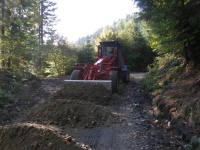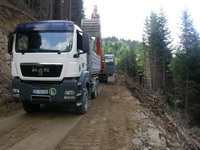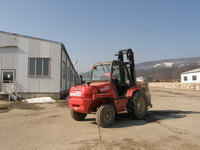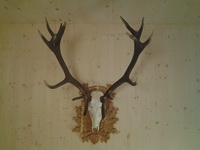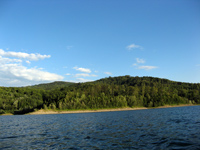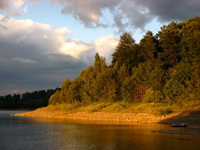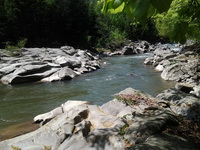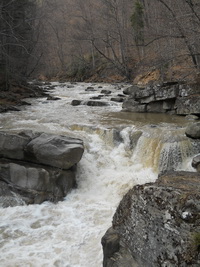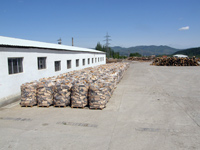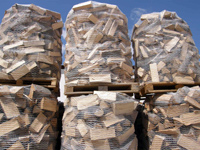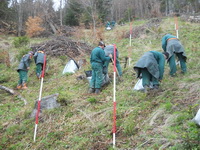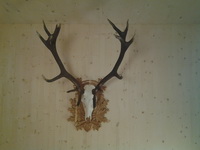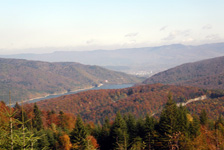 General background
General backgroundStructure of forest district
Organization of forest district
Tending operations and logging
Transport and forest roads
Hunting
General background
Lignum Forest District is a private forest district sustainably managing the forests owned by S.C. Forestier M.U. Silvicultura SRL. Its main tasks are forest management, protection and sustainable management of forest land. S.C. Lignum Forest District S.R.L. is based in Dărmăneşti, approx 60 km away from the city of Bacău.
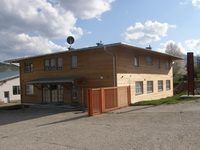
The area of managed forestland is 6,476 ha and part of the mountain chain of Eastern Carpathians, with the Nemira Peak in the south and Lapoş Peak in the north.
The tallest peaks found on the territory of Lignum Forest District are Farcu Mic Peak in the south and Lapoş Peak in the north, both with an elevation of approx 1,360 m.
The Poiana Uzului Lake, supplied by the Uzu Creek, the biggest creek in the area, is located in the middle of the forestland managed by Lignum Forest District. The water suppliers of this creek are Bărzăuţa in the south, Coporîia and Tăietura in the north. Tulburea, Grozea, Izvorul Alb and Plopu Lapoş Creeks are directly supplying the lake.
The mixed stands are predominant, with European beech (Fagus sylvatica L.) and silver fir (Abies alba Mill.) as the most important species. Other tree species found in the stand composition are: sycamore (Acer pseudoplatanus L.), common ash (Frasinus excelsior L.), hornbeam (Carpinus betulus L.), Norway spruce (Picea abies (L.) Karst.), etc. Other species found as scattered individuals are wild service tree (Sorbus torminalis (L.) Cr.) and rowan (Sorbus domestica L.).
The Lignum Forest District has the custody of Izvorul Alb Nature Reserve, where valuable individuals of yew (Taxus baccata L.) are found.
Because of the diversity of herbaceous species as well as of animals in the forests managed by the Lignum Forest District, an important proportion of the area is included into the Natura 2000 site, with the role of protection of flora and fauna; as the forest stands play a high protection function, wood harvest is not allowed.
Structure of forest district
Management of forests
Functionally, the Lignum Forest District is composed of the Uzu Forest Sub-district, with an area of 6,476 ha, divided into four forest ranges:
- Forest range 1: Dealul Mare-Grozea, 1,611 ha
- Forest range 2: Izvorul Alb-Bărzăuţa, 1,813 ha
- Forest range 3: Coporîia-Răchitiş, 1,674 ha
- Forest Range 4: Pârâul Haitei-Caputeanu, 1,377 ha.
Organization of forest district
- Constantin Vasilică, B.Sc.
- Forestland: Dr. Aurica Pătrăucean, B.Sc.
- Forest Protection: Andei Borzoș, B.Sc.
- Guarding and Hunting: Constantin Vasilică, B.Sc.
- Warehouse and Primary wood processing: Vasile Postolachi, technician
- Accounting and Secretariat: Magdalena Milea, accountant
In each forest range, the activity is coordinated by one forest ranger. These people, together with the Head of forest district, coordinate the activity of forest workers performing various daily activities.
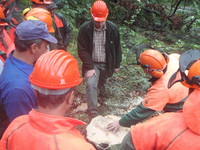
Lignum Forest District has forest work teams composed of lumber men specially qualified: equipment mecahincs, chainsaw workers, and professional drivers. For reasons of continuity and high work quality, all interventions are performed in-house with their own men.
Permanent education and professional development of employees helps maintain the high standards.
Tending operations and logging
For the sustainable management of forestland, Lignum Forest District performs all kinds of silvicultural operations such as:
- Afforestation, weeding
- Tending operations: release cutting, cleaning-respacing, thinning
Afforestation
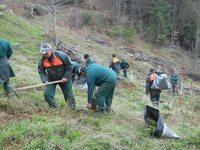
The regeneration of stands managed by Lignum Forest District is mostly accomplished naturally, any artificial intervention being performed only when the optimum stocking is not achieved and established seedlings are not composed of target tree species. Afforestation schemes and compositions are in line with the target species compositions recommended by the technical norms to create stable stands against disturbances.
Tending operations
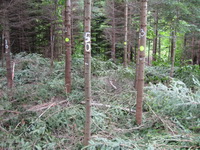
Only by correct and on-time application of tending operations since the early stages of development, can target wood assortments be produced at rotation age.
The stand tending is focusing on positive (individual) selection of trees within stands to allow for an active increment and production of a stable stand against disturbances. Only stands managed accordingly can entirely fulfill the production, protection and recreation functions. As the future of a stand is decided in the early stages of development, a great importance is given to the tending operations. The guidance and control of these interventions are provided by the highly educated staff of Lignum Forest District.
To benefit from state-of-the-art theoretical and practical knowledge regarding the tending operations, the forest district is involved in joint projects with the Faculty of Silviculture and Forest Engineering in Braşov. The research method consists of the establishment of experimental plots in stands included into the 10-year plan of tending operations to guarantee an optimum tending of stands, establishment of a database as well as helping the development of good practice guidelines in the future.
Logging
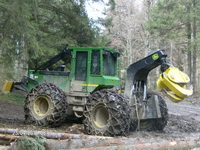
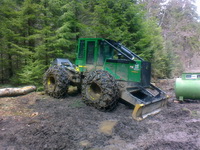
In the stands with wood production functions, Lignum Forest District performs silvicultural systems and tending operations to harvest part of the annual increment and enable the natural regeneration of these stands. Only the sustainable management of forests can provide continuity of wood production for the following generations. Emphasis is placed on the trees and seedlings remaining in the stands, avoiding their wounding. Having as a target the performance of logging based on ecological principles according to the present legislation, Lignum Forest District has invested more than any other private or state forest district in Romania, in state of the art machinery. Mostly in logging activities, specially equipped machinery, with low impacts on forest soils and vegetation, are necessary.
Lignum Forest District owns the following machineries for logging:
- Two John Deere 540 and 548 G III skidders, completely equipped;
- One John Deere 1410D forwarder, used for the suspended transportation of logs in the forests.
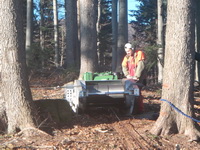
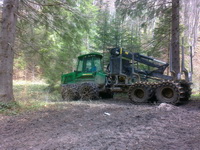
To avoid soil erosion and destabilisation of slopes due to tractor trails, Ligum Forest District has purchased a cableway for logging in order to optimize the sustainable management of forests.
Transport and forest roads
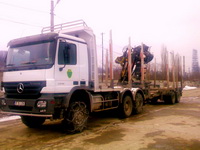
Sustainability means also to provide the market according to its needs with the highest possible constant timber quality. This step is accomplished in the Lignum Forest District with a Mercedes Actros truck, equipped with a trailer for short wood.
Forest roads are crucial for the efficient timber transportation. To keep the roads in good condition and to build new forest roads, Lignum Forest District has its own machinery:
-
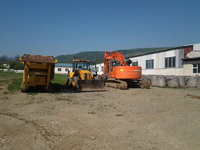 Hitachi Zaxis ZX 225 USCL excavator;
Hitachi Zaxis ZX 225 USCL excavator; - Fiat-Hitachi frontal loader;
- O&K grader;
- Caterpillar compactor;
- Terex bull-excavator;
- MAN truck, with six deck pullers.
The timber is transported to a specially built storage area. There, it is sorted and piled according to the market requirements and it can be checked and picked up by the customers. For sorting, piling and loading, the district owns a Hitachi Zaxis ZW 220 frontal loader, while the manipulation of firewood on pallets is performed with a Manitou.
Hunting
Lignum Forest District manages its own hunting area. In the wild forests of Carpathian Mountains, the managed hunting area has 12,886 ha. Hunting is practiced with passion, damage produced by hunting species to seedlings and trees being insignificant. As large carnivores such as brown bear (Ursus arctos), wolf (Canis lupus) and lynx (Lynx lynx) are present, natural selection is active; individuals forming populations are vigorous, with valuable trophies. In the forest land managed by Lignum Forest District, hunting species are similar to those described in the past by famous hunters such as August V. Spiess, Graf Silva–Tatouca, Graf v. Medveczky and last but not least Erdod V. Pallfy. In our own forestland CIC gold and silver medal trophies of wild boar (Sus scrofa) and red deer (Cervus elaphus) were achieved. Wild boar trophies with a length of 20 cm, as well as red deer trophees weighing 8.9 kg are not unusual for our game.
The hunting methods are either stalking during the calling of stags or by long waits in the hard cold of winter until the arrival of the stag. Brown bear (Ursus arctos) and wolf (Canis lupus) can only be hunted based on derogation.
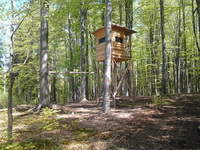
In winter time, wild animals are fed fibre fodder, concentrated mixtures and succulent plants; salt is provided to them all year long. In order to carry out observations of game species some observatories were built.
